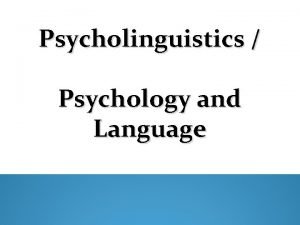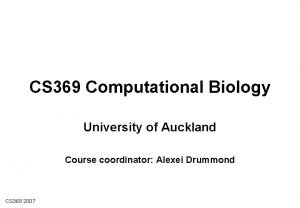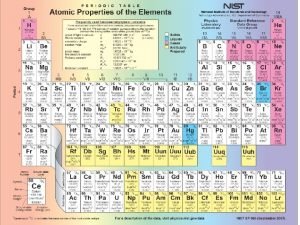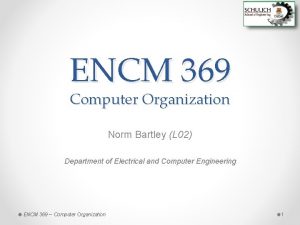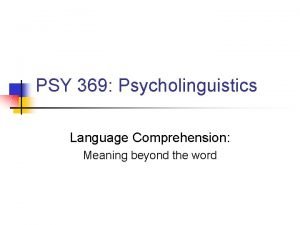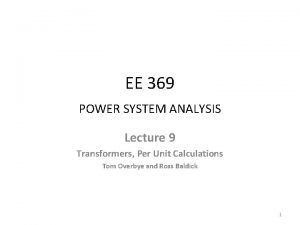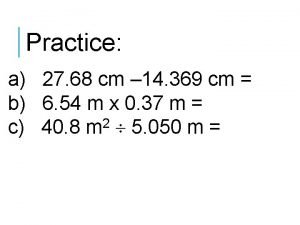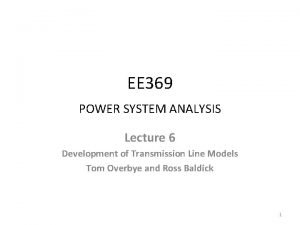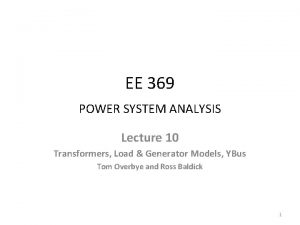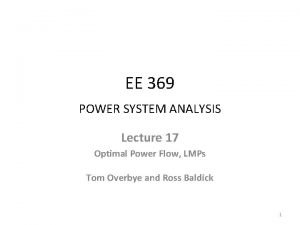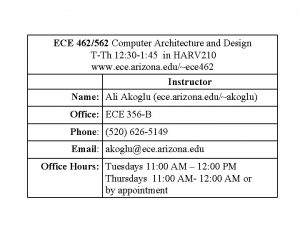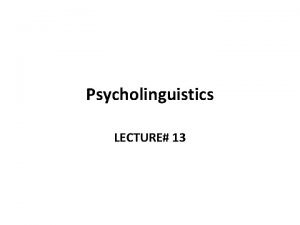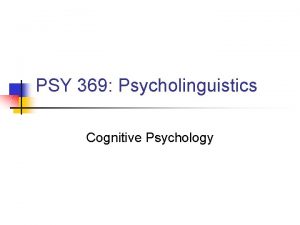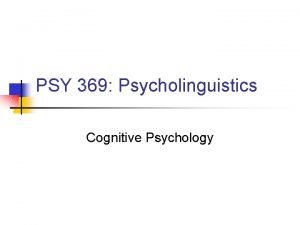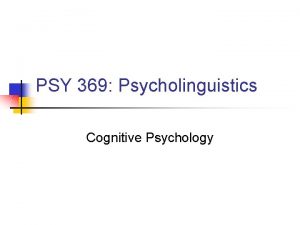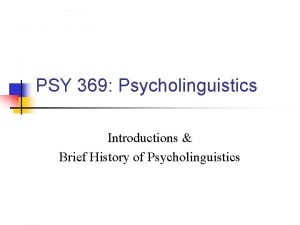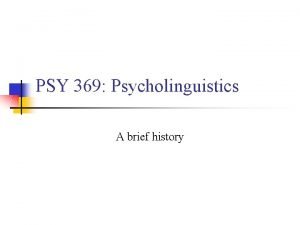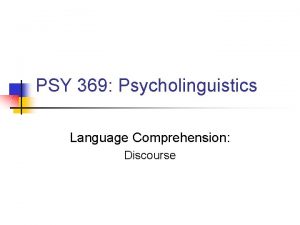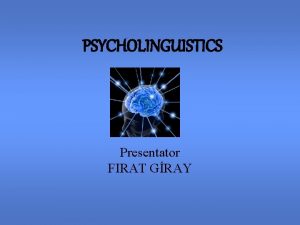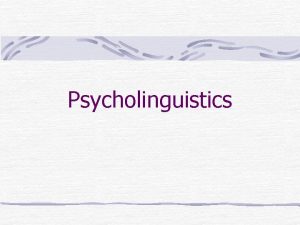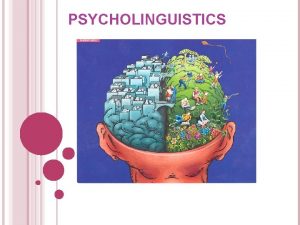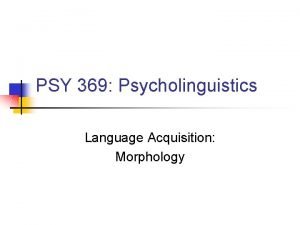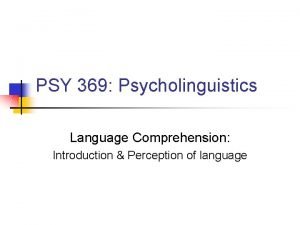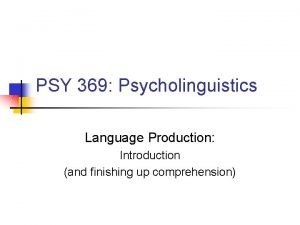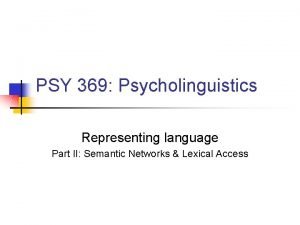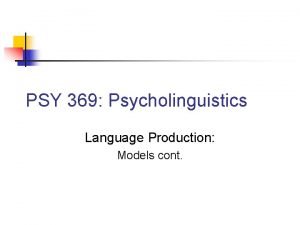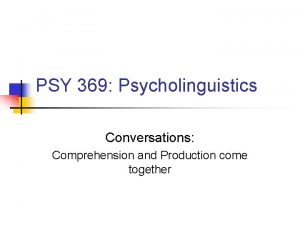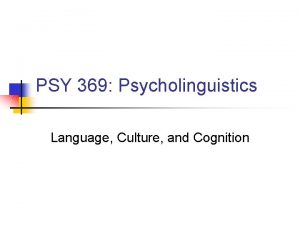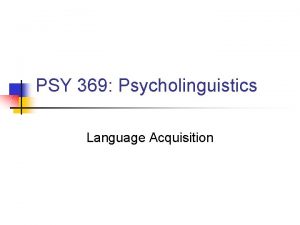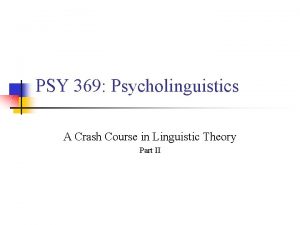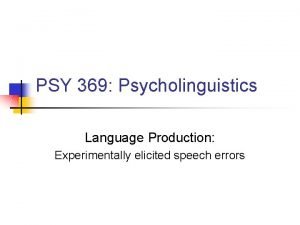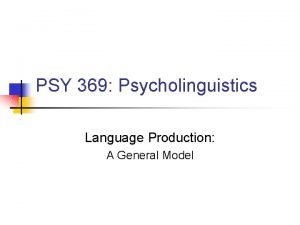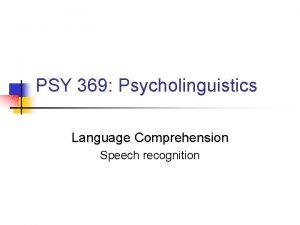PSY 369 Psycholinguistics Cognitive Psychology Day 2 What




























- Slides: 28

PSY 369: Psycholinguistics Cognitive Psychology Day 2

What is “psycholinguistics”? The study of language from a psychological perspective. Psycho Linguistics Mental Processes Linguistic Theory - Short Term Memory Long Term Memory Encoding Retrieval Mental Representations - Phonology - Morphology - Syntax - Semantics - Rules

The ‘standard model’ The Multistore Model

Long term memory n Properties n n n Capacity: Unlimited? Duration: Decay/interference, retrieval difficulty Organization n n Multiple subsystems for type of memory Associative networks (more on these next week)

Long term memory: Capacity n How much can we remember? n n Lots, no known limits to how much memory storage we have. More important issue concerns questions about encoding and retrieval n Encoding - getting memories into LTM what gets in? n n n Rehearsal Depth of processing – organization, distinctiveness, effort, elaboration Retrieval - getting memories out of LTM what gets out? exact memories or reconstructed memories?

Long term memory: Duration n n How long do our memories last? Ebbinghaus (1885/1913) n n n He memorized non-sense syllables. Memorize them until perfect performance, Test to relearn the lists perfectly. n This was called the "savings. "

Long term memory: Duration n n How long do our memories last? Bahrick (1984) n He has done a number of studies asking people about memories for things (e. g. , Spanish, faces of classmates, etc. ) that they learned over 50 years past. He has found evidence that at least some memories stick around a really long time.

Long term memory: Organization n n This theory suggests that there are different memory components, each storing different kinds of information. Declarative n n n The Multiple Memory Stores Theory Declarative n episodic - memories about events semantic - knowledge of facts Procedural - memories about how to do things (e. g. , the thing that makes you improve at riding a bike with practice. Procedural n semantic

Long term memory n How is semantic memory structured? n Networks (more next week)

Attention n Major tool of the central executive n Limited capacity resource n Filtering capabilities n Integration function

Attention: Limited resource n Only have so much ‘energy’ to make things go, so need to divide it and allocate it to processes n Single pool (e. g. , Kahneman, 1973) n n Multiple pools (e. g. , Navon & Gopher, 1979) n n Central bank of resources available to all tasks that need it Several banks of specialized resources – divided up in terms of input/output modalities, stages of info processing (perception, memory, response output) Dual task experiments

Attention: An information filter n Information bottleneck. There is so much info, only some is let through, while the rest is filtered out n n Early selection (e. g. , Broadbent, 1958, Triesman, 1964) Late filters (Deutsch & Deutsch) n n Everything gets in, bottleneck comes at response level (can only respond to limited number of things) Cocktail party effect, dichotic listening

Attention: Integration n Attention is used to ‘glue’ features together n Feature integration theory & Visual search exps Where’s Waldo Find the X X X O X X XX Pop out X O OO XO XO O XX Slow search

Attention: How do we control it? n n Attention as a ‘spotlight’ Move it around

Attention: How do we control it? n n Attention as a ‘spotlight’ Move it around, make it focused or diffuse

Attention: How do we control it? n n n Attention as a ‘spotlight’ Move it around, make it focused or diffuse Is it ‘aimed’ or ‘pulled’

Automaticity n Controlled processes n n Require resources Under some volitional direction Slow, effortful Automatic processes n n n Require little attention Obligatory Fast

Stages of skill acquisition n Cognitive stage n n Associative stage n n Establish declarative encoding of an action Strengthen the connections between elements of the skill Autonomous stage n Skills can be performed without interference form other activities

Bottom-up & Top-down n Terms come from computer science n n Bottom up (data driven) relies upon evidence that is physically present, building larger units based on smaller ones Top down (knowledge driven), using higher-level information to support lower-level processes

Bottom-up & Top-down Selfridge’s Pandemonium system, 1959

Bottom-up & Top-down C T

Bottom-up & Top-down T E

Bottom-up & Top-down T E C T

Bottom-up & Top-down FROG

Bottom-up & Top-down FROG

Bottom-up & Top-down Half the class close your eyes Title: Doing laundry

Bottom-up & Top-down Half the class close your eyes Read story Rate how comprehensible the story is 1 - 2 - 3 - 4 - 5 hard to understand easy to understand

Summing up n Psycholinguistic view n Language and cognition are inextricably linked n Notice that almost all of the experiment demonstrations involved language elements as stimuli
 Day 1 day 2 day 3 day 4
Day 1 day 2 day 3 day 4 Psycholinguistics psychology definition
Psycholinguistics psychology definition Day 1 day 2 day 817
Day 1 day 2 day 817 Cognitive and non cognitive religious language
Cognitive and non cognitive religious language 369 times 2
369 times 2 Cs 369
Cs 369 369
369 Ge power management
Ge power management Norm bartley
Norm bartley 369 meaning
369 meaning 369 power
369 power Bio 369
Bio 369 369 project
369 project Tom overbye
Tom overbye 369 power
369 power 파이썬 369 짝짝
파이썬 369 짝짝 369 power
369 power 68000
68000 Euro psy
Euro psy Psy 2012 ucf
Psy 2012 ucf Psy 2055
Psy 2055 Psy 2055
Psy 2055 Psy2055
Psy2055 Psy
Psy Psy sanin
Psy sanin Psy
Psy Psy 421
Psy 421 Psy
Psy Psy
Psy

